by Meredith
4. April 2014 07:18
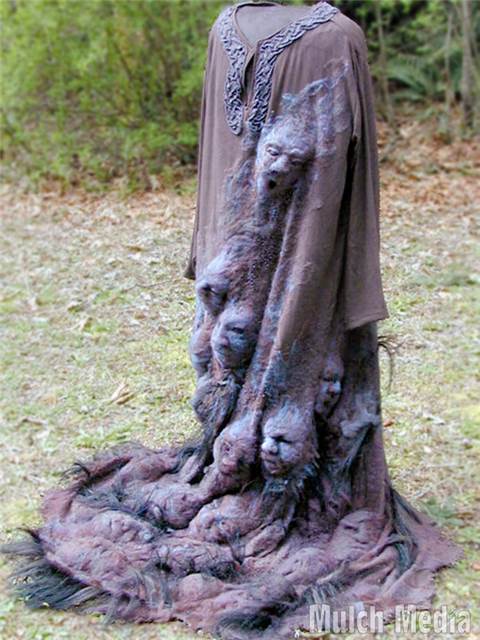 The Gown of Fea the Soul Weaver is an art project that I completed during my senior year at UWT. I'm pulling Fea out of storage and will be displaying her in the art show at Norwescon37. Why? Because Animal X, a costumer who created a costume that was inspirational to the creation of Fea is going to be a guest of honor at the convention. <fan girl squee!>
The Gown of Fea the Soul Weaver is an art project that I completed during my senior year at UWT. I'm pulling Fea out of storage and will be displaying her in the art show at Norwescon37. Why? Because Animal X, a costumer who created a costume that was inspirational to the creation of Fea is going to be a guest of honor at the convention. <fan girl squee!>
To celebrate Fea's public showing I've been freshening up the content on this blog; including a couple of new images for my Pinterest albums. My gallery has all the photos of Fea posted as well as a PDF of the complete story.
All the posts about Fea are available in April 2008 section of this blog. Enjoy!
by Meredith
19. April 2008 15:56
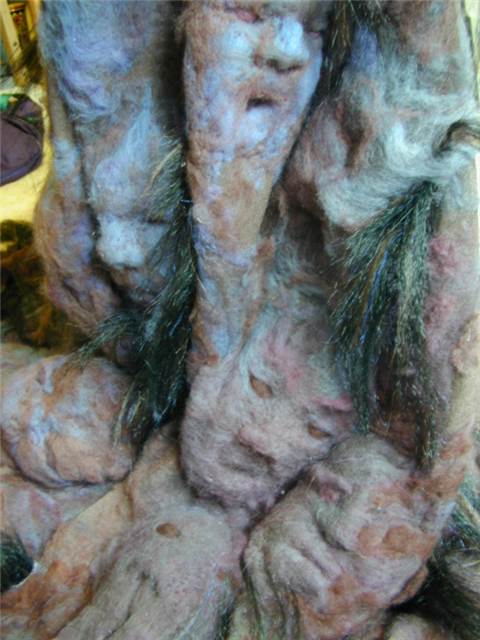 Once all the faces were tacked down into place I started filling the spaces in between with more wool and the hair wefts.
Once all the faces were tacked down into place I started filling the spaces in between with more wool and the hair wefts.
The majority of this work was done with the gown on the dress form to ensure that it would look right. The hair wefts were draped onto the dress and hand-sewn to the fabric.
Later, after I filled in the spaces with additional wool, I trimmed up hair so that each was a length I liked. Similar to how the faces were arranged by color, I filled in with darker colors of the wool as I reached the bottom of the gown. I also ripped up the bottom edge of the dress, fraying all the edges to help add weight to the form.
The final piece of construction was to add some beading. Because souls as I imagine them are mystic, ethereal things, I wanted to have a little bit of sparkle integrated within the wool. I tried out many different patterns and beading techniques and eventually settled on scattering the beads out into some general lines versus having them clumped together or worked into specific patterns.
To plan the layout I used some scrap tule, draping and pinning the lines into a general flow 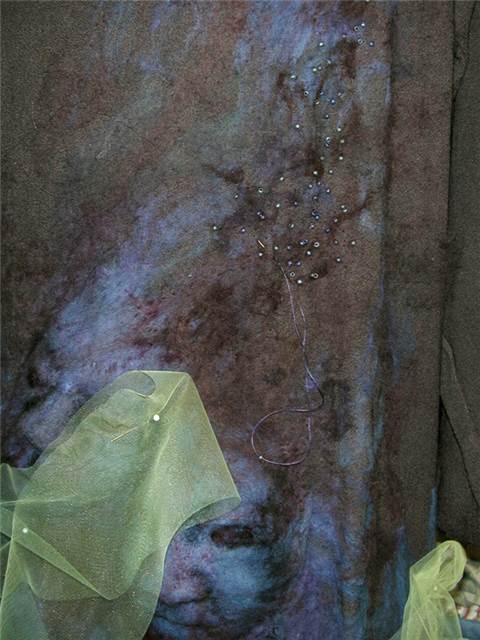 that I liked. Similar to applying heavier and darker amounts of wool at the base of the gown, I also applied heavier amounts of beads.
that I liked. Similar to applying heavier and darker amounts of wool at the base of the gown, I also applied heavier amounts of beads.
by Meredith
18. April 2008 15:49
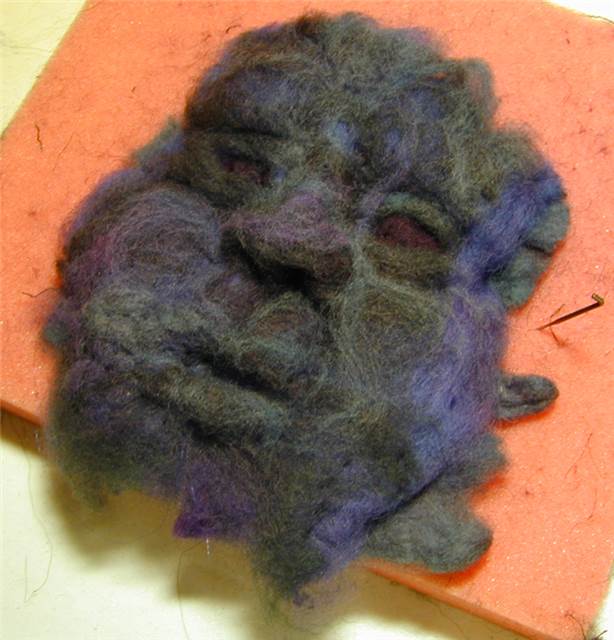 Making the faces took a lot of experimentation but I finally developed a system for I could produce them fairly efficiently and with good results. Many of my early attempts had to be reworked so that they looked better and matched the later version.
Making the faces took a lot of experimentation but I finally developed a system for I could produce them fairly efficiently and with good results. Many of my early attempts had to be reworked so that they looked better and matched the later version.
In general, the method I worked out was to layout several layers of the dyed wool. Each layer was spread out so that the “grain” of the wool was in a different direction. With enough layers so that the wool was about an inch thick I would then felt the layers together with my multi-needle tool. With the lightly felted square I would then pinch in the major features of the face, tacking each into place by using the single needle to push the wool into the foam work surface. I then used the single needle to felt in the rest of the facial details: pushing in recesses like nostrils and wrinkles; teasing out obtrusions like eyebrows and noses; cutting in holes like eye sockets and mouths.
The next step of the project was to arrange all of the faces onto the dress. With the base-fabric gown draped on a dress form, I arranged each of the face with the lightest colors towards the top and the darkest at the bottom. The goal was to add a weight to the garment, to show Fea’s heavy burden while weaving in the souls of the fallen. In addition to the color arrangement, the faces were also rotated and laid out to create a spiral pattern; the faces wind their way up Fea’s form.
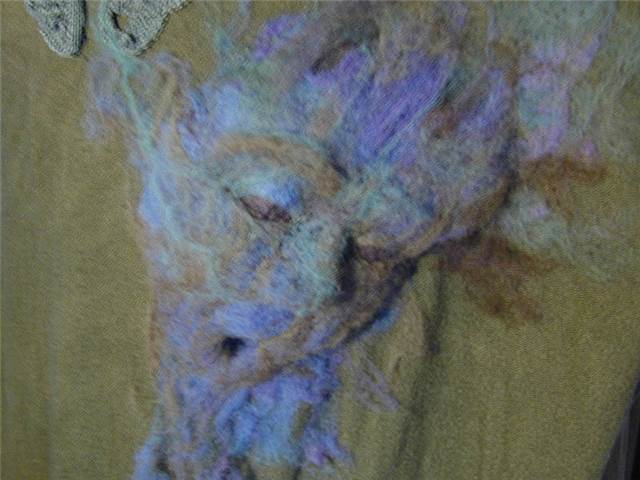 Each face was square and built to look straight on, but I found that with pushing the wool around and adding filler where needed, I could tilt the faces into different directions. After having the general layout planned, I squished and shaping each face, grouping them so that they were looking out in different directions. One of the problems I discovered was that I had to work with the gown on the dress form for all planning. Once I laid the gown flat to work on felting the faces down, the pieces would lay differently; so what didn’t look right laying flat looked great hanging up.
Each face was square and built to look straight on, but I found that with pushing the wool around and adding filler where needed, I could tilt the faces into different directions. After having the general layout planned, I squished and shaping each face, grouping them so that they were looking out in different directions. One of the problems I discovered was that I had to work with the gown on the dress form for all planning. Once I laid the gown flat to work on felting the faces down, the pieces would lay differently; so what didn’t look right laying flat looked great hanging up.
by Meredith
17. April 2008 15:40
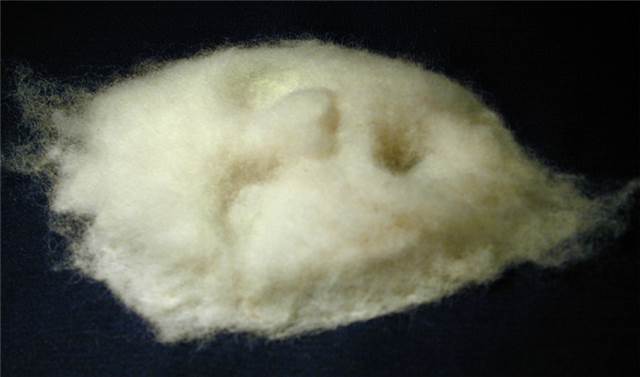 The major exploration portion of the project was devoted to learning about manipulating wool, both with the dying and the felting process.
The major exploration portion of the project was devoted to learning about manipulating wool, both with the dying and the felting process.
First I had to purchase by materials. Based on the recommendation of a friend I bought my wool from bought The Sheep Shed Studio. I ended up buying way more than I actually used: 5lbs and I used about 1 lb. My felting needles were purchased from Wool Works. Once I had the tools and supply of wool I tested out the felting process by making one face. It was fairly time consuming the result worked well enough that believed I could make the project work.
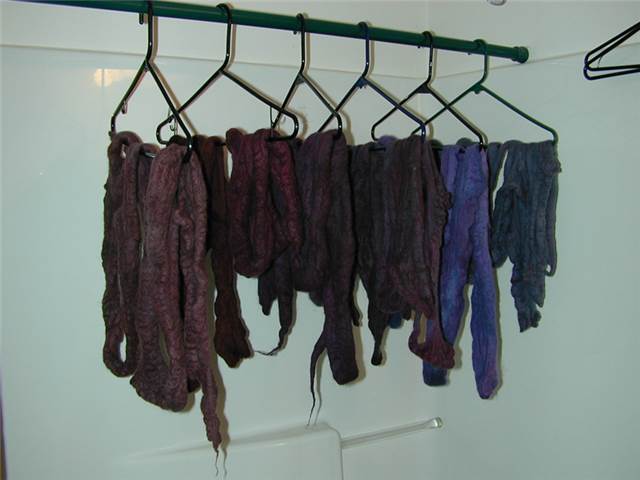 The next step was to dye the wool into the colors I wanted for the project. The best and easiest instructions I found to follow were from Pie Knits’ blog, Feb 20, 2006. This was an incredibly easy and fun process. Because the dyes used were edible (Wilton’s Icing Dye), the entire process could be done in the kitchen using the pots I already had, no special equipment purchases were necessary. Another amazing thing about dying wool is how little mess there is. You know when the dying process is done when all the dye has been absorbed from the water by the wool. Unlike fabric dyes, there is no real rinsing required, the wool as fully absorbed all of the color.
The next step was to dye the wool into the colors I wanted for the project. The best and easiest instructions I found to follow were from Pie Knits’ blog, Feb 20, 2006. This was an incredibly easy and fun process. Because the dyes used were edible (Wilton’s Icing Dye), the entire process could be done in the kitchen using the pots I already had, no special equipment purchases were necessary. Another amazing thing about dying wool is how little mess there is. You know when the dying process is done when all the dye has been absorbed from the water by the wool. Unlike fabric dyes, there is no real rinsing required, the wool as fully absorbed all of the color.
As part of a human and organic element, I wanted to work in a fringe of hair around the wool faces. I made wefts out of a mix of synthetic and human hair. The wefts were made by laying out layers of the three different colors of hair onto a bead of glue. A strip of fabric (so I have something more solid to sew to the dress) is pressed onto the glue. Once dry I cut the strip of fabric down the middle to create two long wefts of hair.
by Meredith
16. April 2008 14:43
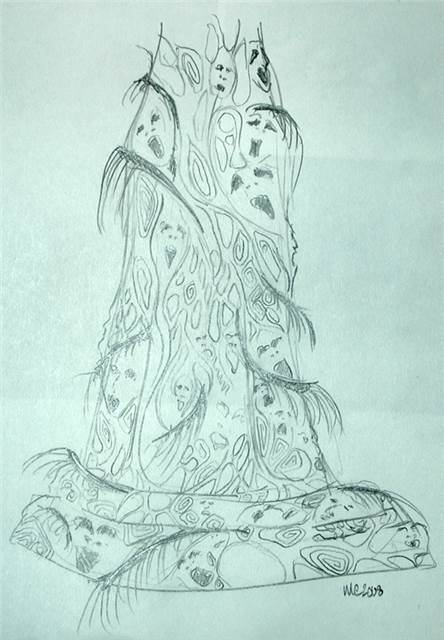
The Fea project developed out of wanting to explore two ideas. The first was based on seeing an image of Animal X’s costume, “Holocaust“. I thought the idea of having faces integrated into a garment was fascinating. Unlike Animal X’s costume though, I wanted to explore making the faces more a part of the garment, like an overall texture.
To find more visual inspiration, I searched the internet for images that had the integrated texture I was wanting. Inge Stahl’s work titled “Medea” and Kalenisis’ photo “Sister of Earth two” were two images that I liked the merging of natural elements onto the female form. A second inspiration was Michelle Wyn-de-Bank and her use of felting to create “Hairy Face” and “Hairy Faces”. I had been exploring the idea of using wool to sculpt the faces and her projects helped to confirm that it would be possible. With these images in mind I made some design sketches to work out what Fea’s gown would look like.
The second idea in the overall development of the project came from wanting to combine storytelling with costume making. The process needed to begin with the story. I knew the character I was creating was going to be a mythological being that gathered souls and integrated the spirits into her garment. The story building then began with searching for a mythology already established. Influenced by the intricate weaving of Celtic knot work, I eventually settled on the Irish mythology of the Tuatha De Danann. As I researched the history of the Tuatha De I found a series of tales that had pieces missing; leaving a perfect opening for me to fit a character within the mythology. Out of the 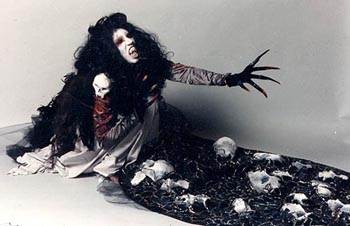 story I’ve described, Neit did have three wives (or a wife with three incarnations). These women were also considered the three incarnations of The Morrigu, a goddess that represented Fate, War and Death. Tuatha De mythology does link The Morrigu’s help in Battle of Mag Tuired and while there was information about Neamin and Badb’s participation, there was nearly nothing about Fea. The void became an open invitation to create a new mythology for this character and that is where I injected my fiction into the actual myths.
story I’ve described, Neit did have three wives (or a wife with three incarnations). These women were also considered the three incarnations of The Morrigu, a goddess that represented Fate, War and Death. Tuatha De mythology does link The Morrigu’s help in Battle of Mag Tuired and while there was information about Neamin and Badb’s participation, there was nearly nothing about Fea. The void became an open invitation to create a new mythology for this character and that is where I injected my fiction into the actual myths.
With a time period determined and a general idea of how the gown was going to look, I also wanted to do some research on period clothing that could have been worn by the Tuatha De. Using the euhemerist idea that the legends of the Tuatha De were based on actual people, there were several dates that estimated when the Tuatha De inhabited Ireland. Scholars placed the approximate time period at 1870 to 1830 BC, during the Bronze Age. There was not a lot of evidence available to explain what the people may have been wearing, but theories suggest that Northern European people wore clothing cut closer to the body than the flowing garments of warmer climates. Though the Vikings didn't come to the area until much later, research suggested that the clothing worn in Ireland was similar in shape and function.
Early Irish Dress
Viking Tunic Construction
by Meredith
15. April 2008 14:33
 "From Concept to Creation: Making Fea's Gown"
"From Concept to Creation: Making Fea's Gown"
Meredith Cook, Senior, Art, Media and Culture
Mentor: Tyler Budge, Interdisciplinary Arts and Sciences
Undergraduate Research Project 2008
Abstract: The Gown of Fea the Soul Weaver is an art project designed to combine storytelling with costume making. The project's scope includes developing the concept of a character and storyline, designing the garment, researching materials and construction methods, and constructing the gown. Nestled within the holes of Irish myth, Fea's story is a combination of carefully chosen elements from the historical legends of the Tuatha De Danann. Even the mythological figure Fea, who's name is based on the Gaelic word for "weave", is chosen to support the initial character concept. Where Fea's traditional history lacks content, a new story is created: During the Tuatha De Danann's battle against the Fomorians, Fea saves the spirits of the dying by weaving their souls into her garments. Designing Fea's gown then becomes an illustration of a moment in her newly created history. To further support the character concept, materials and construction methods are selected to emphasize Fea's action of weaving souls. Materials like hand-dyed wool are sculpted into faces and felted into a base garment. The felting process, like Fea's weaving, knits the individual wool fibers into the weave of the base fabric. Costume construction and materials also include making weft-fringe of human hair, fabric appliqué of Celtic patterns, and hand-sewn beading. The final results of the project should be an art piece that explores elements of shape, materials, and construction that best represent the concepts behind a character's story.
The complete story is available in the gallery.